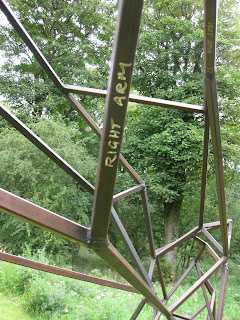 Over Here by Shane Waltener at Jupiter Artland introduces contemporary lace as sculpture in a familiar form - a giant knitted web.
Over Here by Shane Waltener at Jupiter Artland introduces contemporary lace as sculpture in a familiar form - a giant knitted web. Waltener describes the web as "Trapping the essence of the place and framing an ever changing imprint of it". The technique references traditional Shetland lace and the material (fishing line) hints at the the net as a means of capturing prey, a strange mixture in theory but very effective in this situation.
The thread is quite transparent when viewed against the light but,  as with a rainbow, viewed at the right angle that the colours become apparent. It would be great to see this with a backdrop of autumn leaves but sadly I have no plans to be in the area in the fall.
as with a rainbow, viewed at the right angle that the colours become apparent. It would be great to see this with a backdrop of autumn leaves but sadly I have no plans to be in the area in the fall.
 as with a rainbow, viewed at the right angle that the colours become apparent. It would be great to see this with a backdrop of autumn leaves but sadly I have no plans to be in the area in the fall.
as with a rainbow, viewed at the right angle that the colours become apparent. It would be great to see this with a backdrop of autumn leaves but sadly I have no plans to be in the area in the fall. The knitted structure of the work only becomes apparent at close quarters but reminds me of a comment that I once heard; 'women knit - men are continuous loop construction engineers'. Either way this is a work that successfully brings knitting / lace / textiles to the attention of a wider audience. Perhaps not one of his most adventurous pieces but powerfully effective in this setting.
The knitted structure of the work only becomes apparent at close quarters but reminds me of a comment that I once heard; 'women knit - men are continuous loop construction engineers'. Either way this is a work that successfully brings knitting / lace / textiles to the attention of a wider audience. Perhaps not one of his most adventurous pieces but powerfully effective in this setting. 




















